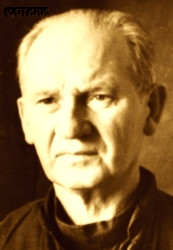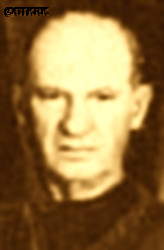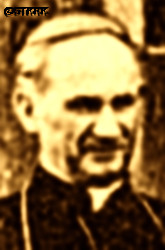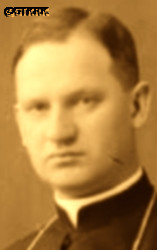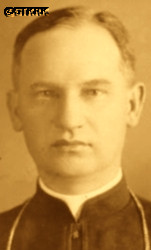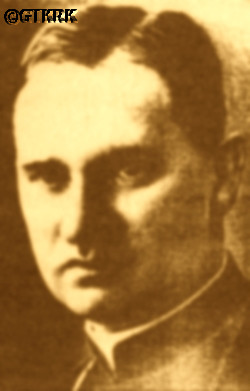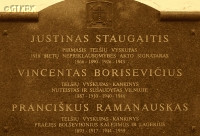Roman Catholic
St Sigismund parish
05-507 Słomczyn
85 Wiślana Str.
Konstancin deanery
Warsaw archdiocese, Poland
full list:
displayClick to display full list

searchClick to search full list by categories
wyświetlKliknij by wyświetlić pełną listę po polsku

szukajKliknij by przeszukać listę wg kategorii po polsku

Martyrology of the clergy — Poland
XX century (1914 – 1989)
personal data
religious status
Servant of God
surname
RAMANAUSKAS
forename(s)
Francis (pl. Franciszek)
forename(s)
versions/aliases
Pranciškus
function
bishop
creed
Latin (Roman Catholic) Church RCmore on
en.wikipedia.org
[access: 2014.09.21]
diocese / province
Telsiai diocesemore on
en.wikipedia.org
[access: 2014.12.20]
academic distinctions
Doctor of Sacred Theology
honorary titles
pontifical prelatemore on
pontifical prelate
(1940)
honorary canonmore on
honorary canon
(1932, St Anthony of Padua RC cathedral church, Telšiaitoday: Telšiai urban eld., Telšiai dist., Telšiai Cou., Lithuania
more on
en.wikipedia.org
[access: 2022.01.06])
Cross of Vytis (Lithuania) — Commander's Grand 2nd Classmore on
Cross of Vytis (Lithuania) – Commander's Grand 2nd Class
(07.06.2006)
nationality
Lithuanian
date and place
of death
15.10.1959

Telšiaitoday: Telšiai urban eld., Telšiai dist., Telšiai Cou., Lithuania
more on
en.wikipedia.org
[access: 2022.01.06]
details of death
After German and Russian invasion of Poland in 09.1939 and start of the II World, after German attack on 22.06.1941 of their erstwhile ally, Russians, hid and provided shelter to a young Jew.
After German defeat in the World War II and start in 1945 of another Russian occupation arrested on 18.12.1946 by the Russians and accused of organization of defense against Bolshevik invasion in 1918‐1920, participation in suppression of Bolshevik coup attempt in 1918, conducting anti–Russian activities after 1944, making anti–Russian homilies and providing support to anti–Russian partisans.
Repeatedly interrogated — c. 60 times, for more than 1,000 hours — maltreated and tortured.
After interrogations witnesses saw him spat blood.
Did not break or reveal anything, and did not admit guilt.
On 16.08.1947 sentenced to 10 years of slave labour in Russian concentration camps Gulag.
Held in Orsza in Belarus, and next in ITL KarLag n. Karaganda, ITL IntaLag (camp #5 and from 1949 camp #1), ITL MinLag, ITL VorkutLag.
In 1954‐1955 held in Abieź camp in Komi republic.
There prob. clandestinely ordained at least two Catholic priests.
On 20.07.1957 released.
Return to Lithuania — exhausted and seriously ill, among others suffering from atherosclerosis — but forbidden to move to Telšiai.
Immediately however started to visit his diocesan priests and parishes, despite being constantly followed by the Russian security forces.
Moved to Švėkšna parish in Šilutė deanery.
Soon forced to undergo two surgeries.
Did not recover and after the second one perished in hospital.
cause of death
extermination
perpetrators
Russians
sites and events
AbezClick to display the description, ITL VorkutLagClick to display the description, ITL MinLagClick to display the description, ITL IntaLagClick to display the description, ITL KarLagClick to display the description, GulagClick to display the description, Ribbentrop‐MolotovClick to display the description, Pius XI's encyclicalsClick to display the description
date and place
of birth
21.11.1893

Kudoniaitoday: Betygala eld., Raseiniai dist., Kaunas Cou., Lithuania
more on
lt.wikipedia.org
[access: 2020.07.31]
parents
RAMANAUSKAS Anthony
🞲 ?, ? — 🕆 ?, ?

JANKAUSKAITĖ Pauline
🞲 ?, ? — 🕆 ?, ?
presbyter (holy orders)
ordination
11.01.1907

Telšiaitoday: Telšiai urban eld., Telšiai dist., Telšiai Cou., Lithuania
more on
en.wikipedia.org
[access: 2022.01.06]
St Anthony of Padua RC cathedral churchmore on
en.wikipedia.org
[access: 2018.09.02]
positions held
1944 – 1959
titular bishop — Carpasia RC diocese — appointment: on 28.02.1944; ordination: on 09.04.1944, St Peter and St Paul the Apostles cathedral in Kaunas
1944 – 1959
auxiliary bishop (Lat. episcopus auxiliaris) — Telšiai RC diocese — appointment: on 28.02.1944
from 1940
rector — Telšiaitoday: Telšiai urban eld., Telšiai dist., Telšiai Cou., Lithuania
more on
en.wikipedia.org
[access: 2022.01.06] ⋄ Theological Seminary
31.07.1932 – 1940
vice–rector — Telšiaitoday: Telšiai urban eld., Telšiai dist., Telšiai Cou., Lithuania
more on
en.wikipedia.org
[access: 2022.01.06] ⋄ Theological Seminary — also: lecturer of pastoral theology and homiletics
1931 – 1932
chancellor — Telšiaitoday: Telšiai urban eld., Telšiai dist., Telšiai Cou., Lithuania
more on
en.wikipedia.org
[access: 2022.01.06] ⋄ Diocesan Curia
24.12.1929 – 1931
professor — Telšiaitoday: Telšiai urban eld., Telšiai dist., Telšiai Cou., Lithuania
more on
en.wikipedia.org
[access: 2022.01.06] ⋄ Theological Seminary — lecturer of pastoral theology and homiletics
08.1927 – 1929
PhD student — Rometoday: Rome prov., Lazio reg., Italy
more on
en.wikipedia.org
[access: 2021.12.18] ⋄ theology, „Gregorianum” [i.e. Lat. Pontificia Universitas Gregoriana (Eng. Pontifical Gregorian University)] — PhD thesis prob. Lat. „De creatione mundi” (Eng. „On the creation of the world”), leading to the PhD in Sacred Theology
1926 – 1927
vice–chancellor — Telšiaitoday: Telšiai urban eld., Telšiai dist., Telšiai Cou., Lithuania
more on
en.wikipedia.org
[access: 2022.01.06] ⋄ Diocesan Curia
1923 – 1926
vicar — Telšiaitoday: Telšiai urban eld., Telšiai dist., Telšiai Cou., Lithuania
more on
en.wikipedia.org
[access: 2022.01.06] ⋄ RC parish ⋄ Telšiaitoday: Telšiai urban eld., Telšiai dist., Telšiai Cou., Lithuania
more on
en.wikipedia.org
[access: 2022.01.06] RC deanery
from 1925
editor — Lit. „Žemaičių prietelius” (Eng. „Samogitian matters”) magazine — also: co‐founder
from 1923
chaplain — Telšiaitoday: Telšiai urban eld., Telšiai dist., Telšiai Cou., Lithuania
more on
en.wikipedia.org
[access: 2022.01.06] ⋄ Teachers' Seminary
1922 – 1923
student — Kaunastoday: Kaunas city dist., Kaunas Cou., Lithuania
more on
en.wikipedia.org
[access: 2022.06.29] ⋄ philosophy, Universitas Vytauti Magni [i.e. Vytautas Magnus University (from 1930) / University of Lithuania (1922‐1930)]
1923
chaplain — Kaunastoday: Kaunas city dist., Kaunas Cou., Lithuania
more on
en.wikipedia.org
[access: 2022.06.29] ⋄ gymnasium
1922 – 1923
chaplain — Kaunastoday: Kaunas city dist., Kaunas Cou., Lithuania
more on
en.wikipedia.org
[access: 2022.06.29] ⋄ prison
1921 – 1922
vicar — Raseiniaitoday: Raseiniai urban eld., Raseiniai dist., Kaunas Cou., Lithuania
more on
en.wikipedia.org
[access: 2020.10.25] ⋄ Assumption of the Blessed Virgin Mary RC parish ⋄ Raseiniaitoday: Raseiniai urban eld., Raseiniai dist., Kaunas Cou., Lithuania
more on
en.wikipedia.org
[access: 2020.10.25] RC deanery
1920 – 1921
vicar — Krekenavatoday: Krekenava eld., Panevėžys dist., Panevėžys Cou., Lithuania
more on
en.wikipedia.org
[access: 2022.02.03] ⋄ RC parish ⋄ Panevėžys / Krokialaukisdeanery names/seats
today: Panevėžys Cou., Lithuania RC deanery
1917 – 1920
vicar — Pumpėnaitoday: Pumpėnai eld., Pasvalys dist., Panevėžys Cou., Lithuania
more on
en.wikipedia.org
[access: 2022.02.03] ⋄ RC parish ⋄ Pasvalystoday: Pasvalys urban eld., Pasvalys dist., Panevėžys Cou., Lithuania
more on
en.wikipedia.org
[access: 2022.06.29] RC deanery
till 1917
student — Kaunastoday: Kaunas city dist., Kaunas Cou., Lithuania
more on
en.wikipedia.org
[access: 2022.06.29] ⋄ philosophy and theology, Theological Seminary
sites and events
descriptions
Abez: Penal GUŁAG camp 274/17 „B” in a village Abez on Usa river, by the Pechorska train line (Kotlas—Vorkuta) in Russian Komi republic (beyond Arctic Circle) belonging to various complexes of slave labour concentration camps: ITL SevPechLag (1940‐1950), ITL IntaLag (1941‐1948), ITL MinLag (1948‐1957) and PechorLag (1950‐1959). Prisoners slaved at coal transport form Vorkuta mines, goods shipments, aforementioned railway line construction, including bridge over Usa river. It contained a „central hospital” for those camps, including totally exhausted inmates of ITL VorkutLag. (more on: zeslaniec.plClick to attempt to display webpage
[access: 2013.08.10], gulagmuseum.orgClick to attempt to display webpage
[access: 2014.11.14])
ITL VorkutLag: Russian Rus. Исправи́тельно‐Трудово́й Ла́герь (Eng. Corrective Labor Camp) ITL Rus. Воркутинский (Eng. Vorkutinskiy) — concentration and slave forced labor camp (within the Gulag complex) — headquartered in the town of Vorkuta in the Republic of Komi (initially prob. in Arkhangelsk Oblast), beyond the Arctic circle. Founded on 10.05.1938. Prisoners slaved at the construction of mines and coal mining (including processing plants, construction and renovation of access railway lines), preparation for industrial purposes and development of molybdenum deposits (including construction of the Vorkuta‐Kharbey power line, experimental enrichment plant, access roads), construction of barges on the Pechora River, construction of a thermal power plant, in various factories (production of bricks, building materials, wood processing, cement, furs, consumer goods), workshops (repair, mechanical), auxiliary agricultural work, etc. At its peak — till the death on 05.03.1953 of Russian socialist leader, Joseph Stalin — c. 73,000 prisoners were held there: e.g. 52,195 (01.01.1946); 62,525 (01.01.1948); 62,676 (01.01.1950); 72,940 (01.01.1951); 41,677 (01.01.1952); 52,453 (01.01.1955); 50,515 (01.01.1956); 49,646 (01.01.1957). In the most tragic year in the history of the camp, 1943, 15.5% of prisoners died. The total number of victims is unknown. Ceased to exist in 1960. (more on: old.memo.ruClick to attempt to display webpage
[access: 2024.04.08])
ITL MinLag: Russian Rus. Исправи́тельно‐Трудово́й Ла́герь (Eng. Corrective Labor Camp) ITL Rus. Минеральный (Eng. Mineral) — concentration and slave forced labor camp (within the Gulag complex) — headquartered in the town of Inta in the Republic of Komi. Founded on 02.28.1948 on the premises of ITL IntaLag camp, until 1954 functioning as the Rus. Особый лагерь (Eng. Special camp) GULAG No. 1. Prisoners slaved in an industrial complex managed by the Russian Ministry of Internal Affairs — in coal mines, gold and quartz mining, construction of new mines, construction of roads and buildings, drainage of land, repair and mechanical workshops, brick kilns, hollow brick factories, logging, etc. At its peak — till the death on 05.03.1953 of Russian socialist leader, Joseph Stalin — c. 35,000 prisoners were held there: e.g. 24,112 (01.01.1949); 28,371 (01.01.1950); 33,056 (01.01.1951); 34,448 (01.01.1952); 27,785 (01.01.1953); 28,055 (01.01.1954). Ceased to exist on 03.06.1957 and got incorporated into the ITL PechorLag camp. (more on: old.memo.ruClick to attempt to display webpage
[access: 2024.04.08], old.memo.ruClick to attempt to display webpage
[access: 2024.04.08])
ITL IntaLag: Russian Rus. Исправи́тельно‐Трудово́й Ла́герь (Eng. Corrective Labor Camp) ITL Rus. Интинский (Eng. Intanskiy) — concentration and slave forced labor camp (within the Gulag complex) — initially headquartered in Vorkuta in the Arkhangelsk Oblast, and then in the town of Inta in the Republic of Komi. Founded on 17.11.1941, separated from the ITL VorkutLag camp. Prisoners slaved at the exploration, development and exploitation of hard coal deposits and mines, at the construction of power plants, narrow‐gauge railways, marinas on the Pechora River, in agriculture. At its peak c. 20,000 prisoners were held there: e.g. 14,885 (01.01.1946); 20,585 (01.01.1947); 18,656 (01.01.1948). Ceased to exist on 30.10.1948 and got incorporated into the ITL MinLag camp. (more on: old.memo.ruClick to attempt to display webpage
[access: 2024.04.08])
ITL KarLag: Russian Rus. Исправи́тельно‐Трудово́й Ла́герь (Eng. Corrective Labor Camp) ITL Rus. Карагандинский (Eng. Karagandskiy) — concentration and slave forced labor camp (within the Gulag complex) — with headquarters in the city of Karaganda, Karaganda Oblast in Kazakhstan. Founded on 17.09.1931. One of the largest in the Gulag complex. It covered an area of 300 by 200 km, with its center in the Dolynka village, c. 45 km from Karaganda. One of the tasks was to grow food, especially animal husbandry, for the emerging centers of coal mining and heavy industry in Kazakhstan. Prisoners slaved in camp workshops (metal processing, drawing, tailoring), in the production of construction materials, in a glassworks, a sugar refinery, a vegetable drying plant, in coal mines, limestone mining, and in fishing. At its peak, c. 65,000 prisoners were held there: e.g. 45,798 (01.01.1943); 50,080 (01.01.1944); 53,946 (01.01.1945); 60,745 (01.01.1947); 63,555 (01.01.1948); 65,673 (01.01.1949); 54,179 (01.01.1950); 45,675 (01.01.1951). In total, c. 1,000,000 people passed through the camp, including many women and children. Many died. It ceased operations on 27.07.1959. (more on: en.wikipedia.orgClick to attempt to display webpage
[access: 2019.10.13])
Gulag: The acronym Gulag comes from the Rus. Главное управление исправительно‐трудовых лагерей и колоний (Eng. Main Board of Correctional Labor Camps). The network of Russian concentration camps for slave labor was formally established by the decision of the highest Russian authorities on 27.06.1929. Control was taken over by the OGPU, the predecessor of the genocidal NKVD (from 1934) and the MGB (from 1946). Individual gulags (camps) were often established in remote, sparsely populated areas, where industrial or transport facilities important for the Russian state were built. They were modeled on the first „great construction of communism”, the White Sea‐Baltic Canal (1931‐1932), and Naftali Frenkel, of Jewish origin, is considered the creator of the system of using forced slave labor within the Gulag. He went down in history as the author of the principle „We have to squeeze everything out of the prisoner in the first three months — then nothing is there for us”. He was to be the creator, according to Alexander Solzhenitsyn, of the so‐called „Boiler system”, i.e. the dependence of food rations on working out a certain percentage of the norm. The term ZEK — prisoner — i.e. Rus. заключенный‐каналоармец (Eng. canal soldier) — was coined in the ITL BelBaltLag managed by him, and was adopted to mean a prisoner in Russian slave labor camps. Up to 12 mln prisoners were held in Gulag camps at one time, i.e. c. 5% of Russia's population. In his book „The Gulag Archipelago”, Solzhenitsyn estimated that c. 60 mln people were killed in the Gulag until 1956. Formally dissolved on 20.01.1960. (more on: en.wikipedia.orgClick to attempt to display webpage
[access: 2024.04.08])
Ribbentrop‐Molotov: Genocidal Russian‐German alliance pact between Russian leader Joseph Stalin and German leader Adolf Hitler signed on 23.08.1939 in Moscow by respective foreign ministers, Mr. Vyacheslav Molotov for Russia and Joachim von Ribbentrop for Germany. The pact sanctioned and was the direct cause of joint Russian and German invasion of Poland and the outbreak of the World War II in 09.1939. In a political sense, the pact was an attempt to restore the status quo ante before 1914, with one exception, namely the „commercial” exchange of the so‐called „Kingdom of Poland”, which in 1914 was part of the Russian Empire, fore Eastern Galicia (today's western Ukraine), in 1914 belonging to the Austro‐Hungarian Empire. Galicia, including Lviv, was to be taken over by the Russians, the „Kingdom of Poland” — under the name of the General Governorate — Germany. The resultant „war was one of the greatest calamities and dramas of humanity in history, for two atheistic and anti‐Christian ideologies — national and international socialism — rejected God and His fifth Decalogue commandment: Thou shall not kill!” (Abp Stanislav Gądecki, 01.09.2019). The decisions taken — backed up by the betrayal of the formal allies of Poland, France and Germany, which on 12.09.1939, at a joint conference in Abbeville, decided not to provide aid to attacked Poland and not to take military action against Germany (a clear breach of treaty obligations with Poland) — were on 28.09.1939 slightly altered and made more precise when a treaty on „German‐Russian boundaries and friendship” was agreed by the same murderous signatories. One of its findings was establishment of spheres of influence in Central and Eastern Europe and in consequence IV partition of Poland. In one of its secret annexes agreed, that: „the Signatories will not tolerate on its respective territories any Polish propaganda that affects the territory of the other Side. On their respective territories they will suppress all such propaganda and inform each other of the measures taken to accomplish it”. The agreements resulted in a series of meeting between two genocidal organization representing both sides — German Gestapo and Russian NKVD when coordination of efforts to exterminate Polish intelligentsia and Polish leading classes (in Germany called «Intelligenzaktion», in Russia took the form of Katyń massacres) where discussed. Resulted in deaths of hundreds of thousands of Polish intelligentsia, including thousands of priests presented here, and tens of millions of ordinary people,. The results of this Russian‐German pact lasted till 1989 and are still in evidence even today. (more on: en.wikipedia.orgClick to attempt to display webpage
[access: 2015.09.30])
Pius XI's encyclicals: Facing the creation of two totalitarian systems in Europe, which seemed to compete with each other, though there were more similarities than contradictions between them, Pope Pius XI issued in 03.1937 (within 5 days) two encyclicals. In the „Mit brennender Sorge” (Eng. „With Burning Concern”) published on 14.03.1938, condemned the national socialism prevailing in Germany. The Pope wrote: „Whoever, following the old Germanic‐pre‐Christian beliefs, puts various impersonal fate in the place of a personal God, denies the wisdom of God and Providence […], whoever exalts earthly values: race or nation, or state, or state system, representatives of state power or other fundamental values of human society, […] and makes them the highest standard of all values, including religious ones, and idolizes them, this one […] is far from true faith in God and from a worldview corresponding to such faith”. On 19.03.1937, published „Divini Redemptoris” (Eng. „Divine Redeemer”), in which criticized Russian communism, dialectical materialism and the class struggle theory. The Pope wrote: „Communism deprives man of freedom, and therefore the spiritual basis of all life norms. It deprives the human person of all his dignity and any moral support with which he could resist the onslaught of blind passions […] This is the new gospel that Bolshevik and godless communism preaches as a message of salvation and redemption of humanity”… Pius XI demanded that the established human law be subjected to the natural law of God , recommended the implementation of the ideal of a Christian state and society, and called on Catholics to resist. Two years later, National Socialist Germany and Communist Russia came together and started World War II. (more on: www.vatican.vaClick to attempt to display webpage
[access: 2023.05.28], www.vatican.vaClick to attempt to display webpage
[access: 2023.05.28])
sources
personal:
newsaints.faithweb.comClick to attempt to display webpage
[access: 2021.12.19], lt.wikipedia.orgClick to attempt to display webpage
[access: 2018.09.02], www.catholic-hierarchy.orgClick to attempt to display webpage
[access: 2021.12.19], www.xxiamzius.ltClick to attempt to display webpage
[access: 2018.09.02], angelorum.ltClick to attempt to display webpage
[access: 2018.09.02]
original images:
www.lkbkronika.ltClick to attempt to display webpage
[access: 2018.09.02], www.xxiamzius.ltClick to attempt to display webpage
[access: 2018.09.02], www.xxiamzius.ltClick to attempt to display webpage
[access: 2018.09.02], www.limis.ltClick to attempt to display webpage
[access: 2018.09.02], lt.wikipedia.orgClick to attempt to display webpage
[access: 2018.09.02], www.partizanai.orgClick to attempt to display webpage
[access: 2018.09.02], genocid.ltClick to attempt to display webpage
[access: 2014.12.20]
LETTER to CUSTODIAN/ADMINISTRATOR
If you have an Email client on your communicator/computer — such as Mozilla Thunderbird, Windows Mail or Microsoft Outlook, described at WikipediaPatrz:
en.wikipedia.org, among others — try the link below, please:
LETTER to CUSTODIAN/ADMINISTRATORClick and try to call your own Email client
If however you do not run such a client or the above link is not active please send an email to the Custodian/Administrator using your account — in your customary email/correspondence engine — at the following address:

giving the following as the subject:
MARTYROLOGY: RAMANAUSKAS Francis
To return to the biography press below:
 Click to return to biography
Click to return to biography








